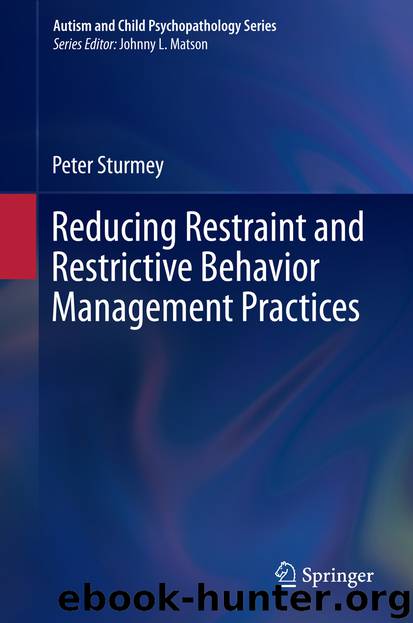Reducing Restraint and Restrictive Behavior Management Practices by Peter Sturmey

Author:Peter Sturmey
Language: eng
Format: epub
Publisher: Springer International Publishing, Cham
7.1.2 Restraints Sometimes Increase Problem Behavior
A second function of restraints is that they may function as positive reinforcers. This may seem paradoxical since, at first sight, one may assume that restraints are aversive stimuli; however, it is not unusual to see some clients with Intellectual Disabilities who ask, point to, and approach their restraint devices, and there are many interventions using restraint that fail to reduce or even increase the target behavior. Hence, the possibility that restraint function as positive reinforcers is worthy of consideration.
Favell et al. (1978) reported three experiments evaluating whether restraint might function as a positive reinforcer. In the first two experiments, they treated self-injurious behavior in three children and adults with severe and profound Intellectual Disabilities. They had informally noted that these participants appeared to enjoy restraints in that they attempted to restrain themselves, appeared calm and happy in restraints, resisted their removal, and became agitated and unhappy when out of restraints. All participants had exhibited self-injurious behavior for many years, and multiple behavioral and other treatments had been ineffective resulting in the clients remaining restrained continuously or almost continuously.
One intervention will be used to illustrate this approach to treatment. Tim, aged 8 years, banged his head and slapped his face. He declined participation in programming and had remained in his bedroom for 2 months, and staff restrained his hands with wrist ties. His self-injurious behavior had resulted in opened sores and bruises, and he was in danger of brain damage from his self-injurious behavior. During the first ten treatment sessions staff said “Tim, get in bed” and restrained him on his bed for 3.5 min contingent upon 3 min of no self-injurious behavior. Staff did not interact with him during restraint. Treatment sessions were 10–42 min in duration. The experimenters used a reversal design. In the first baseline, Tim emitted self-injurious behavior between 30 and 100 % of intervals. During the first treatment phase, he emitted self-injurious behavior during almost no intervals. A brief two-session reversal phase resulted in self-injurious behavior being emitted during 100 % of intervals, and during the final treatment phase, he again emitted self-injurious behavior at near-zero levels. During that final treatment phase, the reinforcement interval was systematically increased from 3 min to 1 h over 14 sessions. The experimenters also faded the restraints by (a) releasing him when he tugged at the restraints so that restraints only lasted 30 s–2.5 min instead of 3.5 min and (b) only placing him on his bed without restraint during the last eight sessions. The experimenters ended contingent access to his bed by the end of 3 months. The experimenters found similar results with two other participants, although details of the treatment packages and restraint-fading procedures varied from person to person.
Further evidence that restraints may function as a positive reinforcer came from experiment 3, which evaluated whether contingent restraint could increase some arbitrary response—placing a marble in a hole in a box. Peg, one of the participants from the earlier experiments, participated. There were three conditions: baseline, intervention, and control.
Download
This site does not store any files on its server. We only index and link to content provided by other sites. Please contact the content providers to delete copyright contents if any and email us, we'll remove relevant links or contents immediately.
Cecilia; Or, Memoirs of an Heiress — Volume 1 by Fanny Burney(32497)
Cecilia; Or, Memoirs of an Heiress — Volume 2 by Fanny Burney(31910)
Cecilia; Or, Memoirs of an Heiress — Volume 3 by Fanny Burney(31894)
The Great Music City by Andrea Baker(31758)
We're Going to Need More Wine by Gabrielle Union(19003)
All the Missing Girls by Megan Miranda(15779)
Pimp by Iceberg Slim(14435)
Bombshells: Glamour Girls of a Lifetime by Sullivan Steve(14022)
For the Love of Europe by Rick Steves(13598)
Talking to Strangers by Malcolm Gladwell(13292)
Norse Mythology by Gaiman Neil(13280)
Fifty Shades Freed by E L James(13187)
Mindhunter: Inside the FBI's Elite Serial Crime Unit by John E. Douglas & Mark Olshaker(9265)
Crazy Rich Asians by Kevin Kwan(9223)
The Lost Art of Listening by Michael P. Nichols(7454)
Enlightenment Now: The Case for Reason, Science, Humanism, and Progress by Steven Pinker(7274)
The Four Agreements by Don Miguel Ruiz(6702)
Bad Blood by John Carreyrou(6583)
Weapons of Math Destruction by Cathy O'Neil(6219)
